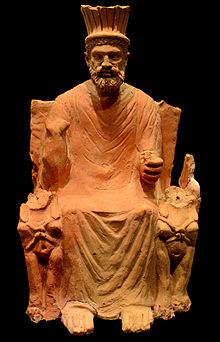Baal Hammon
| Baʿal Ḥammon | |
|---|---|
King of the Gods | |
 Statue of Baʿal Hammon on his throne with a crown and flanked by sphinges, 1st century. | |
| Consort | Tanit |
| Equivalents | |
| Greek equivalent | Cronus |
| Roman equivalent | Saturn |
| Canaanite equivalent | El |
| Deities of the ancient Near East |
|---|
| Religions of the ancient Near East |
Baal Hammon, properly Baʿal Ḥamon (
Etymology
He is clearly identified as one of the Phoenician deities covered under the name of
Others have proposed Hammon as a syncretic association with the Egyptian god Amun,[7] while a last current has called instead for a connection with the Northwest Semitic word ḥammān ("brazier"), suggesting the sense "Lord of the Brazier".[6]
Cult and attributes
The worship of Baʿal Hammon flourished in the
He has been identified with a solar deity,
The interpretatio graeca identified him with the Titan Cronus. In ancient Rome, he was identified with Saturn, and the cultural exchange between Rome and Carthage as a result of the Second Punic War may have influenced the development of the festival of Saturnalia.[13][clarification needed]. Attributes of his Romanized form as an African Saturn indicate that Hammon (Amunus in Philo's work) was a fertility god.[14]

Legacy
There is a survival in modern times in
A street in modern Carthage, located near the Punic Ports, bears the name of Baal Hammon.[17]
The city of Carmona (Andalusia, Spain) is believed to derive its name from Kar-Hammon, "city of Hammon."[18]
See also
- Baʿal Zephon
- Baʿal Zebub
- Punic religion
References
- ISBN 90-429-0770-3.
- ^ Brouillet, Monique Seefried, ed. From Hannibal to Saint Augustine: Ancient Art of North Africa from the Musee du Louvre. Michael C. Carlos Museum, Emory University: Atlanta GA, 1994.
- ^ Serge Lancel. Carthage: A History. p. 195.
- ^ "Carthaginian Religion". World History Encyclopedia. Retrieved 2017-08-04.
- ISBN 9780674091764. Retrieved 19 January 2017.
- ^ a b c Walbank, Frank William (1979). A Historical Commentary on Polybius, Volume 2, Clarendon Press, p. 47
- ^ S. G. F. Brandon, Dictionary of Comparative Religion, 1970, Littlehampton, 978-0297000440
- ISBN 1-85043-533-2
- ^ Kennedy, Maev (21 January 2014). "Carthaginians sacrificed own children, archaeologists say". The Guardian. Retrieved 19 May 2020.
- JSTOR 23734250.
- ISBN 2-503-50033-1).
- ^ Roberto Peter Bongiovanni (2014). "The Interchange of Plain Velar and Aspirate in Kronos/Chronos: A Case for Etymological Equivalence". Master's thesis at City University of New York.
- Robert E.A. Palmer, Rome and Carthage at Peace (Franz Steiner, 1997), pp. 63–64.
- ^ Serge Lancel (1995). Carthage: A History, p197.
- ^ Ottavo contributo alla storia degli studi classici e del mondo antico Arnaldo Momigliano - 1987 p240.
- ^ "Mishnah Sheviit 2:9". www.sefaria.org. Retrieved 2021-08-10.
- ^ /place/Rue+Baal+Hammon,+Tunisie/@36.8480006,10.3239041,753m/data=!3m2!1e3!4b1!4m5!3m4!1s0x12e2b4cac8227357:0x5d79c4f871806c6!8m2!3d36.8479963.26d19028, Rue Baal Hammon Archaeological Site of Carthage, Tunisia, at google.com/maps
- ^ Garvey, G., Ellingham, M. (2003:326). The Rough Guide to Andalucia. United Kingdom: Rough Guides.
External links
- On-line parallel Bible: Song of Solomon 8:11
